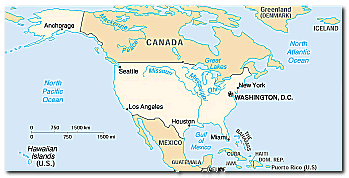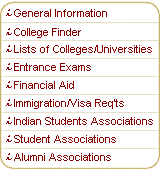 |
|
General Information about the USA
Location: North America, bordering both the North Atlantic Ocean and the North Pacific Ocean, between Canada and Mexico 
Geographic coordinates: 38 00 N, 97 00 W Map references: North America
Area:
Area—comparative: about one-half the size of Russia; about three-tenths the size of Africa; about one-half the size of South America (or slightly larger than Brazil); slightly larger than China; about two and one-half times the size of Western Europe
Land boundaries:
Coastline: 19,924 km
Maritime claims:
Climate: mostly temperate, but tropical in Hawaii and Florida, arctic in Alaska, semiarid in the great plains west of the Mississippi River, and arid in the Great Basin of the southwest; low winter temperatures in the northwest are ameliorated occasionally in January and February by warm chinook winds from the eastern slopes of the Rocky Mountains Terrain: vast central plain, mountains in west, hills and low mountains in east; rugged mountains and broad river valleys in Alaska; rugged, volcanic topography in Hawaii
Elevation extremes:
Natural resources: coal, copper, lead, molybdenum, phosphates, uranium, bauxite, gold, iron, mercury, nickel, potash, silver, tungsten, zinc, petroleum, natural gas, timber
Land use:
Irrigated land: 207,000 sq km (1993 est.) Natural hazards: tsunamis, volcanoes, and earthquake activity around Pacific Basin; hurricanes along the Atlantic and Gulf of Mexico coasts; tornadoes in the midwest and southeast; mud slides in California; forest fires in the west; flooding; permafrost in northern Alaska, a major impediment to development Environment—current issues: air pollution resulting in acid rain in both the US and Canada; the US is the largest single emitter of carbon dioxide from the burning of fossil fuels; water pollution from runoff of pesticides and fertilizers; very limited natural fresh water resources in much of the western part of the country require careful management; desertification
Environment—international agreements:
Geography—note: world's third-largest country (after Russia and Canada) Population: 272,639,608 (July 1999 est.)
Age structure:
Population growth rate: 0.85% (1999 est.) Birth rate: 14.3 births/1,000 population (1999 est.) Death rate: 8.8 deaths/1,000 population (1999 est.) Net migration rate: 3 migrant(s)/1,000 population (1999 est.)
Sex ratio:
Infant mortality rate: 6.33 deaths/1,000 live births (1999 est.)
Life expectancy at birth:
Total fertility rate: 2.07 children born/woman (1999 est.)
Nationality:
Ethnic groups: white 83.5%, black 12.4%, Asian 3.3%, Amerindian 0.8% (1992) Religions: Protestant 56%, Roman Catholic 28%, Jewish 2%, other 4%, none 10% (1989) Languages: English, Spanish (spoken by a sizable minority)
Literacy:
Country name:
Data code: US Government type: federal republic; strong democratic tradition Capital: Washington, DC Administrative divisions: 50 states and 1 district*; Alabama, Alaska, Arizona, Arkansas, California, Colorado, Connecticut, Delaware, District of Columbia*, Florida, Georgia, Hawaii, Idaho, Illinois, Indiana, Iowa, Kansas, Kentucky, Louisiana, Maine, Maryland, Massachusetts, Michigan, Minnesota, Mississippi, Missouri, Montana, Nebraska, Nevada, New Hampshire, New Jersey, New Mexico, New York, North Carolina, North Dakota, Ohio, Oklahoma, Oregon, Pennsylvania, Rhode Island, South Carolina, South Dakota, Tennessee, Texas, Utah, Vermont, Virginia, Washington, West Virginia, Wisconsin, Wyoming
Dependent areas:
American Samoa, Baker Island, Guam, Howland Island, Jarvis Island, Johnston
Atoll, Kingman Reef, Midway Islands, Navassa Island, Northern Mariana
Islands, Palmyra Atoll, Puerto Rico, Virgin Islands, Wake Atoll
Independence: 4 July 1776 (from England) National holiday: Independence Day, 4 July (1776) Constitution: 17 September 1787, effective 4 March 1789 Legal system: based on English common law; judicial review of legislative acts; accepts compulsory ICJ jurisdiction, with reservations Suffrage: 18 years of age; universal
Executive branch:
Legislative branch:
bicameral Congress consists of Senate (100 seats, one-third are renewed
every two years; two members are elected from each state by popular vote to
serve six-year terms) and House of Representatives (435 seats; members are
directly elected by popular vote to serve two-year terms)
Judicial branch: Supreme Court (the nine justices are appointed for life by the president with confirmation by the Senate) Political parties and leaders: Republican Party [Jim NICHOLSON, national committee chairman]; Democratic Party [Steve GROSSMAN, national committee chairman]; several other groups or parties of minor political significance International organization participation: AfDB, ANZUS, APEC, AsDB, Australia Group, BIS, CCC, CE (observer), CERN (observer), CP, EAPC, EBRD, ECE, ECLAC, ESCAP, FAO, G-5, G-7, G-10, IADB, IAEA, IBRD, ICAO, ICC, ICFTU, ICRM, IDA, IEA, IFAD, IFC, IFRCS, IHO, ILO, IMF, IMO, Inmarsat, Intelsat, Interpol, IOC, IOM, ISO, ITU, MINURSO, MIPONUH, MTCR, NATO, NEA, NSG, OAS, OECD, OPCW, OSCE, PCA, SPC, UN, UN Security Council, UNCTAD, UNHCR, UNIDO, UNIKOM, UNMIBH, UNOMIG, UNPREDEP, UNRWA, UNTSO, UNU, UPU, WCL, WHO, WIPO, WMO, WTrO, ZC
Economy—overview: The US has the most powerful, diverse, and technologically advanced economy in the world, with a per capita GDP of $31,500, the largest among major industrial nations. In this market-oriented economy, private individuals and business firms make most of the decisions, and government buys needed goods and services predominantly in the private marketplace. US business firms enjoy considerably greater flexibility than their counterparts in Western Europe and Japan in decisions to expand capital plant, lay off surplus workers, and develop new products. At the same time, they face higher barriers to entry in their rivals' home markets than the barriers to entry of foreign firms in US markets. US firms are at or near the forefront in technological advances, especially in computers and in medical, aerospace, and military equipment, although their advantage has narrowed since the end of World War II. The onrush of technology largely explains the gradual development of a "two-tier labor market" in which those at the bottom lack the education and the professional/technical skills of those at the top and, more and more, fail to get pay raises, health insurance coverage, and other benefits. Since 1975, practically all the gains in household income have gone to the top 20% of households. The years 1994-98 witnessed solid increases in real output, low inflation rates, and a drop in unemployment to below 5%. Long-term problems include inadequate investment in economic infrastructure, rapidly rising medical costs of an aging population, sizable trade deficits, and stagnation of family income in the lower economic groups. The outlook for 1999 is for GDP growth somewhat below 1998's, continued low inflation, and about the same level of unemployment. Two shadows for 1999 are the severe financial crises in East Asia and Russia and the exuberant level of stock prices in relation to corporate earnings. GDP: purchasing power parity—$8.511 trillion (1998 est.) GDP—real growth rate: 3.9% (1998 est.) GDP—per capita: purchasing power parity—$31,500 (1998 est.)
GDP—composition by sector:
Population below poverty line: 13% (1997 est.)
Household income or consumption by percentage share:
Inflation rate (consumer prices): 1.6% (1998) Labor force: 137.7 million (includes unemployed) (1998)
Labor force—by occupation:
managerial and professional 29.6%, technical, sales and administrative
support 29.3%, services 13.6%, manufacturing, mining, transportation, and
crafts 24.8%, farming, forestry, and fishing 2.7% (1998)
Unemployment rate: 4.5% (1998)
Budget:
Industries: leading industrial power in the world, highly diversified and technologically advanced; petroleum, steel, motor vehicles, aerospace, telecommunications, chemicals, electronics, food processing, consumer goods, lumber, mining Industrial production growth rate: 3.6% (1998) Electricity—production: 3.629 trillion kWh (1996)
Electricity—production by source:
Electricity—consumption: 3.666 trillion kWh (1996) Electricity—exports: 9.02 billion kWh (1996) Electricity—imports: 46.543 billion kWh (1996) Agriculture—products: wheat, other grains, corn, fruits, vegetables, cotton; beef, pork, poultry, dairy products; forest products; fish Exports: $663 billion (f.o.b., 1998 est.) Exports—commodities: capital goods, automobiles, industrial supplies and raw materials, consumer goods, agricultural products Exports—partners: Canada 22%, Western Europe 21%, Japan 10%, Mexico 10% (1997) Imports: $912 billion (c.i.f., 1998 est.) Imports—commodities: crude oil and refined petroleum products, machinery, automobiles, consumer goods, industrial raw materials, food and beverages Imports—partners: Canada, 19%, Western Europe 18%, Japan 14%, Mexico 10%, China 7% (1997) Debt—external: $862 billion (1995 est.) Economic aid—donor: ODA, $7.4 billion (1995) Currency: 1 United States dollar (US$) = 100 cents Exchange rates: British pounds (£) per US$—0.6057 (January 1999), 0.6037 (1998), 0.6106 (1997), 0.6403 (1996), 0.6335 (1995), 0.6529 (1994); Canadian dollars (Can$) per US$—1.5192 (January 1999), 1.4835 (1998), 1.3846 (1997), 1.3635 (1996), 1.3724 (1995), 1.3656 (1994); French francs (F) per US$—5.65 (January 1999), 5.8995 (1998), 5.8367 (1997), 5.1155 (1996), 4.9915 (1995), 5.5520 (1994); Italian lire (Lit) per US$—1,668.7 (January 1999), 1,763.2 (1998), 1,703.1 (1997), 1,542.9 (1996), 1,628.9 (1995), 1,612.4 (1994); Japanese yen (¥) per US$—113.18 (January 1999), 130.91 (1998), 120.99 (1997), 108.78 (1996), 94.06 (1995), 102.21 (1994); German deutsche marks (DM) per US$—1.69 (January 1999), 1.9692 (1998), 1.7341 (1997), 1.5048 (1996), 1.4331 (1995), 1.6228 (1994); Euro per US$—0.8597 (January 1999) Fiscal year: 1 October—30 September Telephones: 182.558 million (1987 est.)
Telephone system:
Radio broadcast stations: AM 4,987, FM 4,932, shortwave 0 Radios: 540.5 million (1992 est.) Television broadcast stations: more than 1,500 (including nearly 1,000 stations affiliated with the five major networks—NBC, ABC, CBS, FOX, and PBS; in addition, there are about 9,000 cable TV systems) (1997) Televisions: 215 million (1993 est.)
Railways:
Highways:
Waterways: 41,009 km of navigable inland channels, exclusive of the Great Lakes Pipelines: petroleum products 276,000 km; natural gas 331,000 km (1991) Ports and harbors: Anchorage, Baltimore, Boston, Charleston, Chicago, Duluth, Hampton Roads, Honolulu, Houston, Jacksonville, Los Angeles, New Orleans, New York, Philadelphia, Port Canaveral, Portland (Oregon), Prudhoe Bay, San Francisco, Savannah, Seattle, Tampa, Toledo
Merchant marine:
Airports: 14,459 (1998 est.)
Airports—with paved runways:
Airports—with unpaved runways:
Heliports: 122 (1998 est.)
Military branches:
Department of the Army, Department of the Navy (includes Marine Corps),
Department of the Air Force
Military manpower—military age: 18 years of age
Military manpower—fit for military service:
Military expenditures—dollar figure: $267.2 billion (1997 est.) Military expenditures—percent of GDP: 3.4% (1997 est.) Disputes—international: maritime boundary disputes with Canada (Dixon Entrance, Beaufort Sea, Strait of Juan de Fuca, Machias Seal Island); US Naval Base at Guantanamo Bay is leased from Cuba and only mutual agreement or US abandonment of the area can terminate the lease; Haiti claims Navassa Island; US has made no territorial claim in Antarctica (but has reserved the right to do so) and does not recognize the claims of any other nation; Marshall Islands claims Wake Atoll Illicit drugs: consumer of cocaine shipped from Colombia through Mexico and the Caribbean; consumer of heroin, marijuana, and increasingly methamphetamines from Mexico; consumer of high-quality Southeast Asian heroin; illicit producer of cannabis, marijuana, depressants, stimulants, hallucinogens, and methamphetamines; drug-money-laundering center

|
 |
|||||||||||||||||||||||||||||||||
|
 |
|||||


